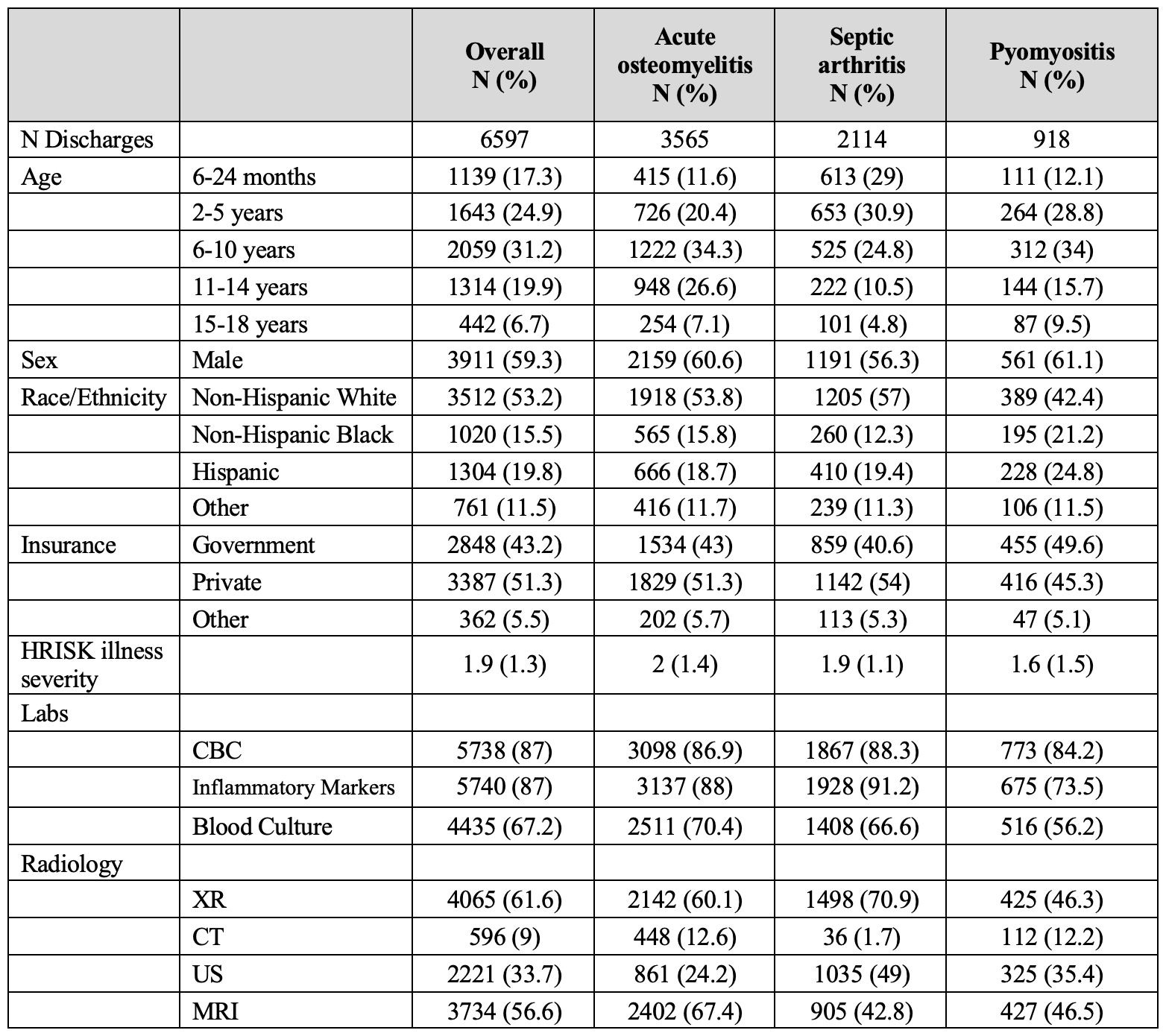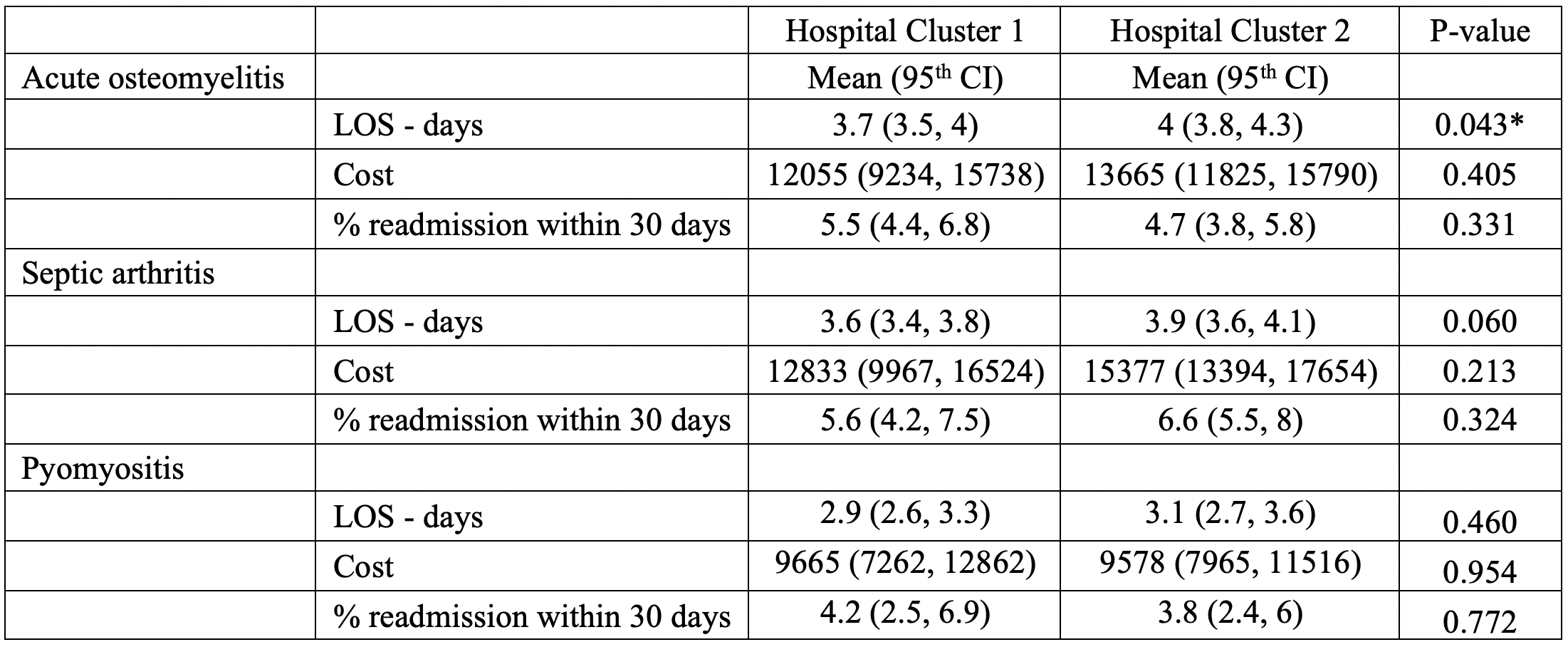Hospital Medicine: Clinical
Category: Abstract Submission
Hospital Medicine: Clinical - Infectious Disease NOS
320 - Variation in Laboratory and Radiographic Workup and Outcome in Children Hospitalized with Common Musculoskeletal Infections
Saturday, April 23, 2022
3:30 PM - 6:00 PM US MT
Poster Number: 320
Publication Number: 320.213
Publication Number: 320.213
Emily Bonanni, Children's Mercy Hospitals and Clinics, Prairie Village, KS, United States; Matthew Hall, Children's Hospital Association, Lenexa, Kansas, KS, United States; Jessica Bettenhausen, Children's Mercy Kansas City, Kansas City, MO, United States; Rana E. El Feghaly, Children’s Mercy Kansas City, UMKC, Kansas City, MO, United States; Kathryn Kyler, Children's Mercy Hospitals and Clinics, Kansas City, MO, United States
- EB
Emily Bonanni, MD
Pediatric Hospital Medicine Fellow
Children's Mercy Hospitals and Clinics
Prairie Village, Kansas, United States
Presenting Author(s)
Background: Common pediatric musculoskeletal infections (MSKIs) require prompt recognition and treatment to prevent significant morbidity and mortality. Variation in the initial workup of these infections and associations with clinical outcomes is not well studied and could aid development of evidence-based guidelines providing high-value care for all MSKIs.
Objective: To examine variation in initial laboratory testing and imaging obtained in patients hospitalized for common MSKIs and explore association with clinical outcomes (length of stay (LOS), cost, 30-day readmission).
Design/Methods: We performed a retrospective, multicenter cohort study of hospitalized children aged 6 months to 18 years with a discharge diagnosis of acute osteomyelitis, septic arthritis or pyomyositis from 1/1/16 to 6/30/20 using the Pediatric Health Information System (PHIS) database. We collected rates of common lab testing (complete blood counts [CBC], inflammatory markers [IM], blood culture) and radiographic studies (ultrasound [US], x-ray [XR], magnetic resonance imaging [MRI], computed tomography [CT] scan) obtained on hospital days 0 and 1. K-means clustering grouped hospitals based on the frequency with which lab and imaging studies were obtained. Logistic regression was used to determine associations between overall cluster utilization and risk-adjusted patient outcomes.
Results: We identified 6597 children admitted across 44 hospitals with an included MSKI diagnosis. More than half of these patients were 2-10 years of age, with a majority being male (Table 1). Most children ( >84%) had CBC or inflammatory markers, with some variation across diagnoses. MRI and X-ray imaging were used most frequently (56 and 59%, respectively) with some variation across diagnoses (Table 1). Cluster 1 (15 hospitals) showed slightly higher laboratory utilization and lower US use (Figure 1) with significantly shorter hospital LOS for patients with acute osteomyelitis (3.7 vs. 4.0 days, p-value 0.043; Table 2) but with no significant difference in cost or readmission rates. There were no outcome differences for patients with septic arthritis or pyomyositis. Conclusion(s): Despite a lack of universal practice guidelines in the work up and management of pediatric MSKIs, little variation existed in workup or outcomes across hospitals. This may be due to similarities in initial presentation of various MSKIs. Future investigations of differences in more detailed patient-level clinical factors (e.g., lab results, vitals) on initial presentation or downstream hospital management could elucidate if associations with outcomes exist between different MSKIs.
Table 1: Demographic Characteristics & Resource Utilization by Diagnosis Abbreviations: CI, Confidence Interval; HRISK, Hospitalization Resource Intensity Scores for Kids; CBC, Complete Blood Count; XR, X-ray, CT, Computed Tomography; US, Ultrasound; MRI, Magnetic Resonance Imaging
Abbreviations: CI, Confidence Interval; HRISK, Hospitalization Resource Intensity Scores for Kids; CBC, Complete Blood Count; XR, X-ray, CT, Computed Tomography; US, Ultrasound; MRI, Magnetic Resonance Imaging
Table 2: Risk Adjusted Outcomes Abbreviations: CI, Confidence Interval; LOS, Length of Stay
Abbreviations: CI, Confidence Interval; LOS, Length of Stay
Objective: To examine variation in initial laboratory testing and imaging obtained in patients hospitalized for common MSKIs and explore association with clinical outcomes (length of stay (LOS), cost, 30-day readmission).
Design/Methods: We performed a retrospective, multicenter cohort study of hospitalized children aged 6 months to 18 years with a discharge diagnosis of acute osteomyelitis, septic arthritis or pyomyositis from 1/1/16 to 6/30/20 using the Pediatric Health Information System (PHIS) database. We collected rates of common lab testing (complete blood counts [CBC], inflammatory markers [IM], blood culture) and radiographic studies (ultrasound [US], x-ray [XR], magnetic resonance imaging [MRI], computed tomography [CT] scan) obtained on hospital days 0 and 1. K-means clustering grouped hospitals based on the frequency with which lab and imaging studies were obtained. Logistic regression was used to determine associations between overall cluster utilization and risk-adjusted patient outcomes.
Results: We identified 6597 children admitted across 44 hospitals with an included MSKI diagnosis. More than half of these patients were 2-10 years of age, with a majority being male (Table 1). Most children ( >84%) had CBC or inflammatory markers, with some variation across diagnoses. MRI and X-ray imaging were used most frequently (56 and 59%, respectively) with some variation across diagnoses (Table 1). Cluster 1 (15 hospitals) showed slightly higher laboratory utilization and lower US use (Figure 1) with significantly shorter hospital LOS for patients with acute osteomyelitis (3.7 vs. 4.0 days, p-value 0.043; Table 2) but with no significant difference in cost or readmission rates. There were no outcome differences for patients with septic arthritis or pyomyositis. Conclusion(s): Despite a lack of universal practice guidelines in the work up and management of pediatric MSKIs, little variation existed in workup or outcomes across hospitals. This may be due to similarities in initial presentation of various MSKIs. Future investigations of differences in more detailed patient-level clinical factors (e.g., lab results, vitals) on initial presentation or downstream hospital management could elucidate if associations with outcomes exist between different MSKIs.
Table 1: Demographic Characteristics & Resource Utilization by Diagnosis
 Abbreviations: CI, Confidence Interval; HRISK, Hospitalization Resource Intensity Scores for Kids; CBC, Complete Blood Count; XR, X-ray, CT, Computed Tomography; US, Ultrasound; MRI, Magnetic Resonance Imaging
Abbreviations: CI, Confidence Interval; HRISK, Hospitalization Resource Intensity Scores for Kids; CBC, Complete Blood Count; XR, X-ray, CT, Computed Tomography; US, Ultrasound; MRI, Magnetic Resonance ImagingTable 2: Risk Adjusted Outcomes
 Abbreviations: CI, Confidence Interval; LOS, Length of Stay
Abbreviations: CI, Confidence Interval; LOS, Length of Stay